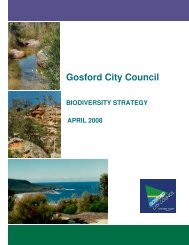Gosford City Council Historical Water Quality Review & Analysis
Gosford City Council Historical Water Quality Review & Analysis
Gosford City Council Historical Water Quality Review & Analysis
Create successful ePaper yourself
Turn your PDF publications into a flip-book with our unique Google optimized e-Paper software.
FUTURE DIRECTIONS FOR WATER QUALITY / ENVIRONMENTAL HEALTH MONITORING 4-3<br />
4.2.1.2 Seagrass<br />
The depth range of the seagrass Zostera capricorni is monitored twice yearly at 18 locations<br />
throughout Moreton Bay. In the bay, the depth at which this seagrass can grow depends on water<br />
quality, particularly light availability (refer Figure 4.2). Detection of changes to the seagrass depth<br />
range therefore provides an indication of long term integrated water quality throughout the bay and if<br />
it is impacting on the integrity of these critical habitats.<br />
Figure 4.2 Seagrass depth range measures the distance between the upper tidal<br />
limit of seagrass distribution and the lower light-limited distribution<br />
4.2.1.3 Sewage<br />
Sewage effluent can contribute to the eutrophication of receiving estuarine and coastal waterways. It<br />
is important to be able to trace the source and extent of sewage effluent in receiving waters in order to<br />
evaluate the extent of its impact on the ecosystem. The use of nitrogen stable isotopes enables the<br />
detection and delineation of sewage-derived nitrogen from other nitrogen sources entering the<br />
waterways and its potential influence on the ecosystem. The most abundant form of naturally<br />
occurring nitrogen is 14 N. Sewage is generally enriched in 15 N compared to 14 N and therefore the<br />
relative proportion of 15 N to 14 N, referred to as d 15 N, is elevated in receiving waters of sewage<br />
treatment plants.<br />
4.2.1.4 Report cards<br />
Report cards are provided annually outlining the overall condition of the South-East Queensland<br />
waterways, based on the EHMP results. An example of an EHMP report card is provided in Figure<br />
4.3, while an example plot of the spatial representation of the Ecosystem Health Index is presented in<br />
Figure 4.4.<br />
The report cards provide a clear picture of the overall health of the waterways, and more importantly,<br />
how they relate to previous years. By comparing the waterway health with past results, managers and<br />
decision-makers can obtain quantitative feedback on the relative success of various management<br />
measures implemented within the catchments. The report cards are released each year amid the<br />
Annual Riverfestival, which is designed to maximise community awareness and ownership of the<br />
waterways and their issues.<br />
D:\R.N0754.002.01.DOC 7/11/03 16:11
















